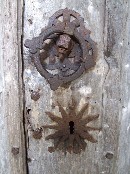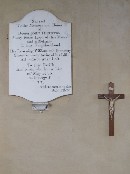| |
|
 |
|
The village straggles along
the lonely lanes between Redgrave
and Bardwell.
It is an intensely rural place, with none
of the commuter feel of villages closer
to Ipswich
and Bury.
Fields intersperse houses, hedges strike
up gentle slopes. When I first came this
way on a day in late August 1999, a
freshly stubbled hay field spread beneath
St Mary, lending it a grandeur as fierce
as any church in the county possessed. I
could not get inside that day, and did
not come back for nearly nine years. Now,
in the early spring of 2008, St Mary was
a great ship in a still sea of green, a
long causeway curving gently around to
meet it in the west.
|
When
Cautley's editors
came here, they found the tower damaged by a
lightning strike, but one would never know this
today. It has been repaired in the conventionally
restrained 20th century manner, as at Orford.
Otherwise, the church bears all the hallmarks of
its 19th century restoration. The chancel was
rebuilt quite early, in the 1840s, suggesting the
influence of the Tractarians, and the entrance to
the 15th century porch was recut. The niche above
is probably original, though.
Today,
St Mary lists its keyholders, and visitors are
welcome. You step into a great barn of a place,
full of light. Medieval survivals are few, but
fascinating. A strip of wood on the south nave
wall is pierced by tracery holes, and was
probably part of the rood loft. Mortlock tells the
tale of how it was found when the village post
office was hit by a bomb during World War Two.
Intriguingly, the churchwarden at the time of the
1840s restoration was the village postmaster, and
it seems safe to assume that he took this
medieval panel home, perhaps to use in a repair.
Opposite,
high in the tracery of a north window, are two
roundels that appear to be 15th century. One
depicts the eagle of St John, while the other
show a fat little kneeling monk with the
inscription Thomas Albi.
The
memorial carver John Bacon produced a very early
work in the chancel here, and it is signed J
Bacon Jnr. Ft. ('J Bacon Junior made this').
As it was made in the 1790s, we must assume it
was reset here when the chancel was rebuilt.
| Part of that rebuilding is
one of the oddest piscinas I've ever
seen, with fluted columns rising to a
panel depicting Christ with the woman at
the well. It would not look out of place
in an Italian Catholic church, and I did
wonder if some London or Birmingham
workshop had produced it for a
commission, only for a civil war to
intervene, and the Market Weston
churchwarden to snap it up from the sale
shelf. Perhaps it was the same one who
stole the rood loft panel. All
in all, the interior of St Mary is a
testament to that great age of Faith, the
19th century. Elements of the past have
been preserved, and there is a sense of
the renewal which the Victorians
engineered, but retaining a character
which is at once rural and devotional; I
like it a lot for that.
|
|
 |
|
|
|

